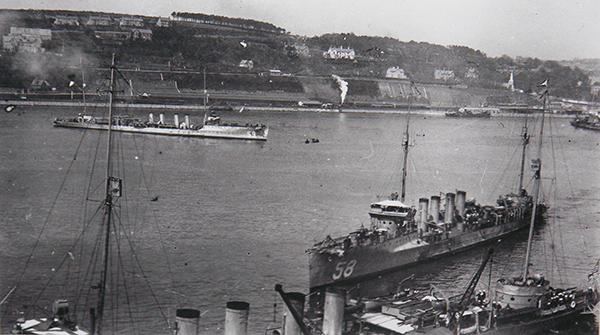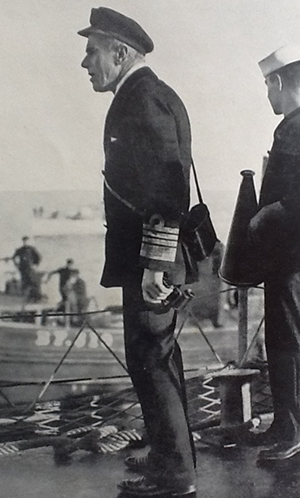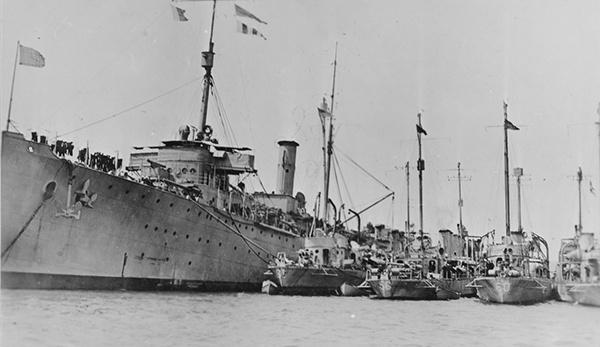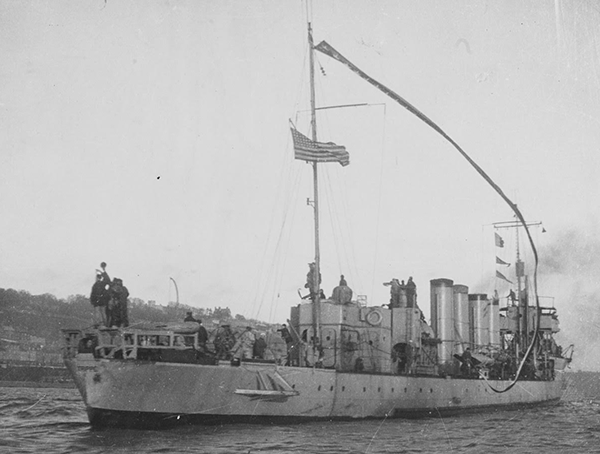The US Navy at Queenstown
Published in Features, Issue 3 (May/June 2017), Volume 25, World War IThe first military intervention of the United States in World War I.
By Daire Brunicardi
On 4 May 1917 a flotilla of unusual vessels appeared off the Daunt lightship at the approaches to Cork Harbour. These were destroyers of the United States Navy; with their low profile and four stubby funnels, they were quite different in appearance to the ships of the British Navy, so familiar in Cork Harbour after almost three years of war.
Submarine warfare
While the reasons why America entered the war against Imperial Germany are complex, one of the principal factors was the German submarine campaign. This had caused annoyance to the United States since its inception in 1915, and the horror and revulsion aroused by the sinking of the Lusitania nearly brought America into the war at that stage. It was therefore appropriate that ships of the US Navy were first into action, to take part in countering that campaign.
At the start of the war the submarine was really an unknown quantity, whether as asset or threat. As in so many aspects of that war, modern technology had far outpaced the rules and military doctrines drawn up in the previous century. Machine-guns, aircraft, radio, mines and submarines changed warfare in a way that officers and political leaders found very difficult to manage. The endurance of submarines was about three days away from base. Both sides considered the submarine as a tactical weapon, to be used in conjunction with the surface fleet. It soon became apparent that this tactical use proved less than satisfactory. Simply put, submarines could not keep up with the fleet, and primitive communication methods and equipment further restricted cooperation between surface and subsurface units. On the outbreak of the war the British had imposed a ‘distant blockade’, blocking off the North Sea to most shipping and cargoes bound for Germany, with increasing effectiveness. The German response was to attempt to impose the same on Britain. Using surface ships was out of the question—the German navy was not powerful enough—so it fell to the U-boat fleet to implement it.

38 Above: The arrival of the first ships of the US Navy into Cork Harbour in May 1917. The USS Wadsworth is alongside the fuelling jetty at the bottom of the photo, with the USS Conyngham approaching to berth alongside. The USS Porter is mooring to a buoy in the middle of the harbour (US Naval Heritage and History Command).
The Hague Convention and ‘Cruiser Rules’
The Hague Convention had what were called the ‘Cruiser Rules’. These required, in time of war, that a naval vessel stop a merchant ship of an enemy state and make provision for the safety of the crew before sinking or capturing the ship. Neutral shipping could also be boarded and searched for ‘contraband’, cargo that could be of military benefit to the enemy. Initially the U-boat commanders attempted to apply the Rules, but of course this eliminated the submarine’s main defence, its invisibility. Besides, unlike a surface ship, a submarine could not take the crews of sunken ships aboard; they had to be left to the doubtful safety of their ships’ lifeboats, often in bad weather and far from land. The British quickly sent out heavily armed disguised merchant ships, the famous ‘Q ships’, which had some success in sinking or seriously damaging U-boats. Britain also armed ordinary merchant ships and expected them to resist being stopped and boarded, which was contrary to the Hague Convention. This encouraged U-boat commanders to torpedo ships without warning. The sinking of the liner Lusitania horrified the world and served to limit the actions of German submarines to some extent, but in early 1917 Imperial Germany declared a war zone around the British Isles within which all shipping, belligerent or neutral, would be sunk without warning.
This had immediate and dire consequences for Britain. The US had sent Admiral William Sowden Sims, an enthusiastic Anglophile, to London to consult on the matter. He learned that, at the current rate of sinkings, Britain would be out of essential supplies by mid-1917 and might be compelled to seek some kind of armistice with Germany. This led to the decision to send destroyers to support the British Navy.

Above: British Vice Admiral Sir Lewis Bayly—seen here on board the US destroyer Cushing at Queenstown—was in overall command.
The flotilla of ships that arrived on 4 May was under the command of Acting Commander Joseph Knefler Taussig, captain of the USS Wadsworth. They were to come under the command of British Vice Admiral Sir Lewis Bayly, with his headquarters on the hill above the town of Queenstown (Cobh). There were some reservations about Bayly’s well-known abrasive manner in dealing with the Americans. In his memoirs Bayly said that the Admiralty asked him to be ‘nice’ to the Americans. He decided that he would treat them exactly as he would British officers. Recounting their first meeting, Sims described Bayly as being as rude as it was possible for one man to be to another, but they subsequently became very friendly. It seems that in general the US ships and personnel fitted in well; when Bayly asked Taussig on arrival when his ships would be ready, he replied that they would be ready as soon as they had refuelled.
The first flotilla was quickly reinforced by further flotillas. The small naval dockyard and establishment on Haulbowline Island in Cork Harbour and other dockyards and facilities in the area could not cope with this influx of ships and men. For example, the naval hospital on Haulbowline and the local hospital in Queenstown were overwhelmed by the requirements of US personnel for minor injuries and illnesses, and the local hospital was also considered primitive by them. Very soon the harbour was graced by a naval hospital, recreational facilities, stores and radio communications, with all the prodigality that was to characterise US military expeditions in the twentieth century.
There were soon two depot ships, dozens of large motor-launch ‘sub-chasers’, tugs and even a squadron of submarines with a depot ship (based in Berehaven). Later naval aircraft arrived, with air stations at Aghada in Cork Harbour, on Whiddy Island in Bantry Bay and other places. It is worth noting that this operation based on the depot ships, which provided administration, stores, repairs and fuel, was to demonstrate what was, in effect, a mobile naval base. The lessons learned in Ireland were to prove immensely valuable in the naval war in the Pacific Ocean 25 years later.
Trouble with the locals
The various accounts of the time portray remarkable cohesion and friendly cooperation between the two navies. That was the style of such writing in the period; any disagreement was rarely, if ever, mentioned. No doubt there was some friction, where two navies with different cultures and traditions came together, but the only trouble mentioned was that between the US servicemen and the young men of the city of Cork. Sims, who had no time for Irish national aspirations, tried to ascribe a political motive to it, but by most accounts—and far more believably—the local boys were simply chagrined by the impact that attractive young foreigners with plenty of cash had on the young women of the city. After a few clashes, including one in which a US sailor was seriously injured, the city was put out of bounds to the US Navy men below the rank of lieutenant. It didn’t stop the young ladies taking the train to Queenstown, however.

Above: The USS Melville—one of two US depot ships—with destroyers alongside. They were moored west of Haulbowline Island in Cork Harbour.
There was friction at the highest level within the US Navy, between Sims and Navy Secretary Josephus Daniels. Sims felt that the US Navy’s principal role was the protection of trade and the maintenance of the supply lines to Britain, while Daniels wanted the Navy to concentrate on protecting the transit of the army to France. Consequently a large part of the US Navy in European waters was based in Brest. As it happened, both objectives were achieved; no US army personnel were lost on the way to Europe, although an empty troop transport was sunk by the Germans.

Above: The USS Trippe leaving Queenstown for the last time. Note the very long ‘paying off’ pennant, and men waving to those ashore.
Anti-submarine measures
At the start of the war there were really no effective weapons against submarines. The ‘Q ships’ and armed merchant ships mentioned above were two measures. Hundreds of fishing vessels and other craft, such as steam yachts, were commandeered, armed and sent on futile patrols, which the U-boats easily avoided. Depth charges were developed, and had some limited effect when a submarine was detected and was close enough. Hydrophones could be used to hear the submerged submarine, but if the listening craft was moving its engines and propellors drowned out the noise of the submarine. In any case, the hydrophones could only indicate with very little precision the direction from which the submarine noise was coming, and could give no range.
The most effective measure that served to neutralise the submarine campaign was the adoption of convoys for merchant ships. For several years there had been advocates for this, but the British naval authorities were largely against it for several reasons. Its adoption soon after the Americans entered the war would seem to suggest that they had some influence on the decision. When Taussig first arrived, before the adoption of the convoy system, he was amazed at the quantity of shipping to be seen every day on the south coast of Ireland. After the adoption of convoys, one German submarine commander wrote that ‘suddenly the sea was empty of ships’.
By the time of the armistice in November 1918 there was a huge US naval presence in Ireland, principally in Queenstown. It far outnumbered the British Navy in Irish waters but remained under the command of a British admiral. The Americans departed Queenstown and Ireland in early 1919. Their presence has left little lasting effect; it’s as if they were never there. Many of the shore establishment buildings were temporary and made of timber, and most of these were dismantled. There are a few, but very few, tangible indicators to be seen today: the flying-boat bases at Whiddy Island in Bantry Bay and Aghada in Cork Harbour have left concrete aprons and slipways, and at Aghada there are two small concrete gateless gateposts, with ‘US Naval’ engraved on one and ‘Air Station’ on the other.
Daire Brunicardi is a former Senior Lecturer at the Cork Institute of Technology/National Maritime College of Ireland.
FURTHER READING
D. Brunicardi, Haulbowline, the naval base and ships of Cork Harbour (Dublin, 2012).
W.S. Delany, Bayly’s navy (Washington DC, 1980).
L. Nolan & J.E. Nolan, Secret victory (Cork, 2009).
















